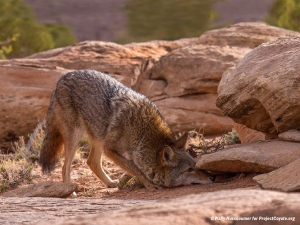Cover Photo ©Wally Nussbaumer for projectcoyote.org —
Coyotes adapt easily to living near people. In fact, the Alaska Department of Fish and Game’s (ADF&G) coyote profile states, “In the wake of man’s relentless expansion into wildlife’s domain, few species have been able to coexist and even expand their range as well as the coyote.”

©Wally Nussbaumer for projectcoyote.org
Resembling a scruffy underfed German shepherd, coyotes are generally nocturnal and secretive creatures that avoid human contact. This is why even though coyotes roam throughout our forests, parks, and neighborhoods we rarely see one. Therefore, for me, it is thrilling to catch a glimpse of one darting across a trail or bounding through a meadow. When I do see one, I think, “how cool.”
On the other hand, if such an encounter takes place during an interpretive program, a guest may spew vitriol about a coyote eating his or her cat. Having lost a cat to a coyote, I empathize while thinking, “how cool, a teachable moment.”
My reaction to a coyote sighting often sets the tone for how my guests perceive an encounter. Therefore, when I see a coyote, I exclaim, “A coyote, how cool is that?” I then listen to a guest’s story about a coyote snatching a pet. Often guests just want to be heard, and once heard, are more receptive to learning how humans need coyotes more than they need us.
Ecological Role
“Coyotes play an important ecological role by keeping other wildlife in check,” I explain to guests. “If we eliminate coyotes, our yards and gardens may be damaged by rodents, rabbits or raccoons. They also eat squirrels, skunks, raccoons, snakes and feral cats that eat eggs and baby birds, thereby negatively affecting songbird populations. As scavengers, coyotes are housekeepers of their range, cleaning up animals hit by cars, die naturally or left behind by other predators. In short, coyotes are our friends if we manage our coyote interactions.”
Projectcoyote.org offers a variety of educational resources to download.
“It appears that this newcomer to the Alaskan scene…has found a niche in our state.“
— Alaska Department of Fish & Game Coyote Profile

© Wally Nussbaumer for projectcoyote.org
Howls, Yips and Yaps
The ADF&G species profile also states that humans’ fear of coyotes is rooted in the history and folklore of the American West and magnified by:
- their stealthy nocturnal behavior.
- their high-pitched howls, yips and yaps.
- news reports of rare attacks on humans.
- movies portraying coyotes as marauding.
My guests often find it surprising to learn coyote attacks on people are rare. According to the Humane Society of the United States “more people are killed by errant golf balls and flying champagne corks each year than are bitten by coyotes.” The thought of airborne corks and wayward golf balls usually elicits laughs from my guests and lightens their moods as we continue down the trail♦
Aleta Walther © 2020
Naturalist & Outdoor Adventure Tour Guide
Gastineau Guiding Company, Juneau, Alaska
aleta@prwriterpro.com
Interpreting the Misinterpreted

An adaptable species indeed. Did I mention smart, cunning and resourceful?
Indeed beautiful, cunning, resourceful and great parents.
Coyotes have made a home in Oklahoma for decades. Use to hear them on Larry’s ranch in Wewoka back in the 80s.
I actually wonder at the magnificent nature of the coyotes.
I have seen them up close walking calmly in my neighborhood, or in the middle of the night, youngster noses pressed against my front gate trying to reach my chihuahua for a midnight snack.
Nice article.